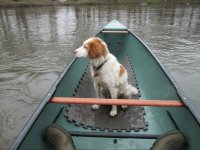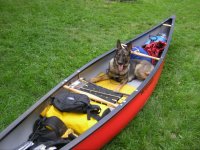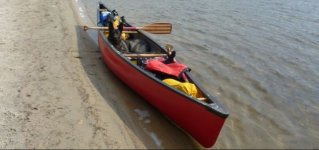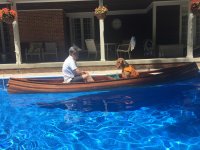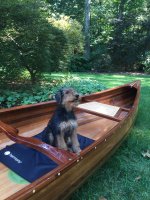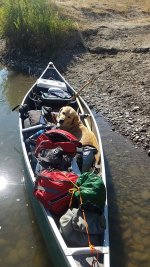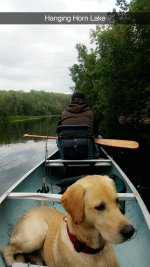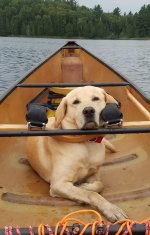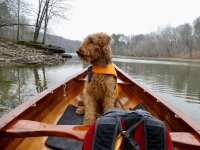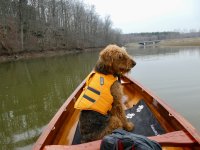Sweetfancymoses - Your picture with your dog standing made me cringe! I travel in relatively stable canoes and my 95# labrador Boomer makes the craft so tippy when he stands that he is rarely allowed to.
In preparation for our first trip, we spent a few afternoons on a backyard pond or a local lake attempting to fish. It was very stressful on both of us but somehow we stayed dry. I was seriously worried that my dream of taking him tripping would be impossible but it turned out far better than I thought after limiting his space with gear. When we were alone in the canoe, he would move from side to side, lean on one gunwale or the other, and generally make counter balancing him a nightmare. When he would suddenly turn to look from port to starboard (prey drive!) would be unnerving for me. What I learned to do is to limit his space so that he simply could not throw his weight around. I always have a tall, backpacking style pack as my primary pack and I have him share a compartment with it, side-to-side. I try to place/tie the pack as close to the gunwale as possible, which not only is necessary for his comfort but also puts his weight a little closer to center. Most of the time I need to place other cargo to the side opposite him to help balance his weight. He can sit up, lean on the pack if he wants to and look around without upsetting the canoe as much as if he could stand up and throw his weight to one side or the other. At first he would protest and try to enter the canoe in the compartment I was paddling in, or climb on top of packs in another compartment but he has learned his place and is quite pleased to be along. A few trips like this and he (almost) understands the concept of balance and can be trusted with more room, and I will even solo with him in an empty canoe today. It should be noted here that I have never had him in a canoe that was narrower than 30" and I pack heavier than some.
It was a headache to start, obedience is very critical, especially with an active and alert hunting\working dog, but now after 3 years of tripping he is a pro. Someday I hope to build a sleek solo canoe for the two of us and let him have his own, narrower compartment. I know he can handle it now that he has experience, but it would have been more of a headache to start this way.
The first picture is the only decent picture I could find of this arrangement, and it is quite embarrassing given the poor organization of the huge amount of gear. 10 days, no portages, beer.
The third picture is from our most recent trip together. When he has this much space I still use a paddle when he first sits down to pry him closer to center. That 18'6" canoe is impossible for me to handle alone, but with his weight I was able to go fishing in the early morning AND make it back to camp when the wind picked up.
EDIT for grammar and realizing I never said anything about "introducing" him to the canoe. He loves the water, and he loves being with me so that part was easy. I got in the canoe, gave him the same command I give him to get into a vehicle (load up) and he jumped right in. One stressful training day, I believe it was our second, he wasn't wanting to get back into the canoe, so I took off and he swam after. I made him follow me for a while before pulling over and by then he had figured out that he would much rather be in the canoe.

